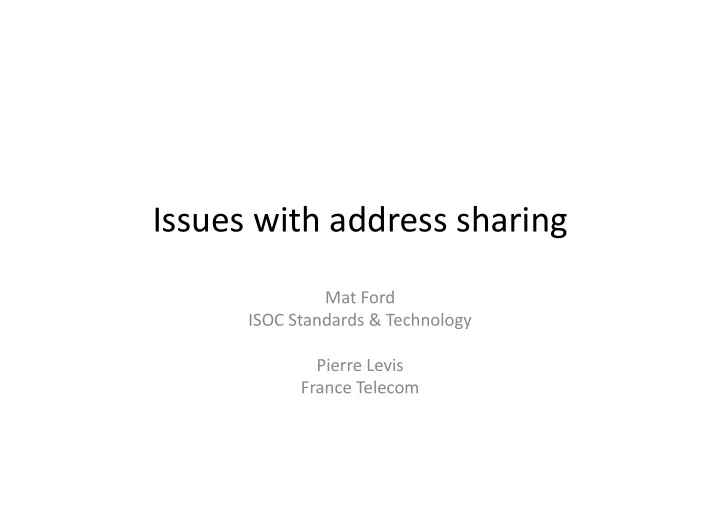

Issues with address sharing Mat Ford ISOC Standards & Technology Pierre Levis France Telecom
Address Sharing • Current prac@ce: give a unique IPv4 public address to each customer – this address can be shared into the Home LAN through a NAPT device (in the CPE) • With IPv4 free‐pool alloca@on comple@on this is no longer possible – Scalability of RFC1918 space also crea@ng problems • A possible solu@on: allocate the same IPv4 public address to several customers at the same @me – this is what we call address sharing Address sharing is the common objec@ve of all IPv4 shortage solu@ons (CGN,DS‐lite, Double NAT, Layer2‐Aware NAT, Port Range, …)
Some principles • End‐to‐end principle * may be under pressure but disregard it at your peril – “The end‐to‐end principle is arguably the fundamental principle of the Internet architecture. In a sense the Internet is the embodiment of the principle. By allowing either tacit or explicit erosion of the principle as we apply our understanding to the construc=on and opera=on of the global network, we allow the dismantling of the u=lity itself.” • IPv6 is the goal * See RFC1958, 3724 3
Criteria for judging ISP responses • How easy is it for the end user to control the impact of the address sharing solu@on on the end‐to‐end communica@on? – No helpdesk calls to get incoming ports allocated, please • Extent to which solu@on offers a natural progression to widespread deployment of IPv6 – Tunnel over IPv6, NAT464, etc. 4
Issues • Broken apps • Port distribu@on, port reserva@on, port nego@a@on • Connec@ons to WKPs • UPnP • Security and Subscriber iden@fica@on • Performance/Resilience 5
What breaks? • Apps that – Establish inbound communica@ons – Carry port info in the payload – Carry address info in the payload – Use Well‐Known Ports – Do not use ports (ICMP) – Assume uniqueness of IP addresses – Explicitly prohibit mul@ple simultaneous connec@ons from the same IP address • Fragmenta@on 6
Port distribu@on • Outgoing connec@ons – Source port number usually irrelevant • Incoming connec@ons – Specific numbers mafer • External referrals • Stable over @me – for how long? • How many ports is enough? – How far off do you need to push IPv6 deployment? – Ac@ve subscribers use >80 ‐ >160 ports at a @me on average * • Distribu@on heavy‐tailed • How many of your customers is it OK to annoy? *hfp://www.wand.net.nz/~salcock/someisp/flow_coun@ng/result_page.html 7
Port distribu@on • If port‐ranges uniformly sized then how many ports is enough? • If ports dynamically allocated without upper limit then heavy‐users, or infected hosts can exhaust the shared resource – DoS against a single address would effect mul@ple subscribers. • Ports must be allocated based on assump@ons about the average number of ports per ac@ve‐ user and the typical number of simultaneous average users. 8
Well‐known ports • Which port is your webserver on today? • Proposals for applica@on service loca@on protocols haven’t gained much trac@on, historically 9
UPnP • UPnP monotonically increases port number un@l it finds something usable, or gives up • Can’t be redirected to use a valid port • So it might work, if you get lucky • UPnP IGD 2.0 will probably fix this for new/ upgraded devices 10
Security and Subscriber iden@fica@on • Logging IP addresses no longer sufficient • If you see hundreds of connec@ons from mul@ple ports, you have to log them all as may be mul@ple users ‐ increased OPEX • Penalty boxes – No way of knowing whether mul@ple connec@on afempts from a single IP are a result of shared addressing or abuse • Port randomisa@on has reduced effec@veness in mi@ga@ng blind afacks – Randomisa@on on OS may be defeated by non‐ implementa@on on shared‐addressing CPE 11
Subscriber management for SPs • Customer iden@fica@on no longer possible based solely on IP address • OSS will require updates for – ac@va@on of services – management of customer profiles – LI – Traceability and mandated logging • Considerably more onerous where CGN is present 12
Performance/Resilience • Addi@onal latency due to having to request a new port prior to every DNS query? • Reduced network resilience • Malicious users sharing my address can now impact my connec@vity 13
Aren’t we here already? • To some extent modem pools and NAT already cause these problems • Widespread adop@on of shared‐addressing mechanisms will make them much more prevalent and much more severe – Broken apps are more annoying when there’s nothing you can do about it – Users must be able to determine their representa@on on the network for some semblance of end‐to‐end to work 14
Conclusions • Shared addressing will mean – Degraded network experience for many users – Reduced security – Higher costs for service providers – As yet unclear, but poten@ally significant, impacts on content providers • The poten@al for all Internet users to be service providers is fundamental to the u@lity of the network • Are there circumstances under which this could be worth it? 15
16
Recommend
More recommend